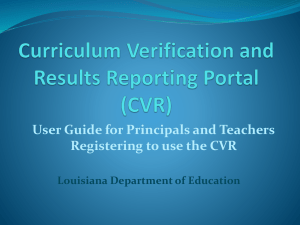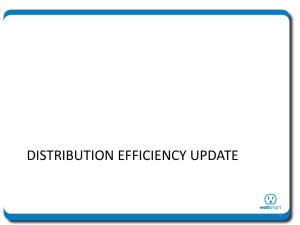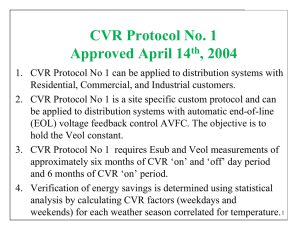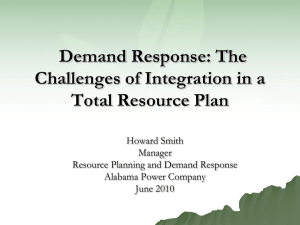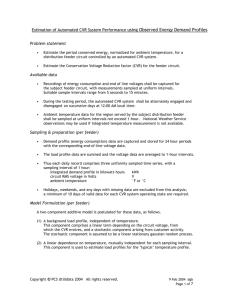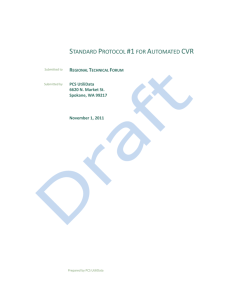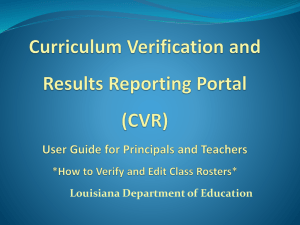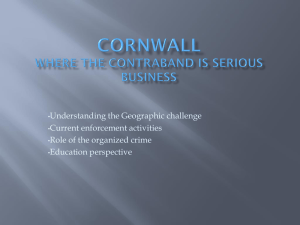Regional Technical Forum Automated Conservation Voltage
advertisement
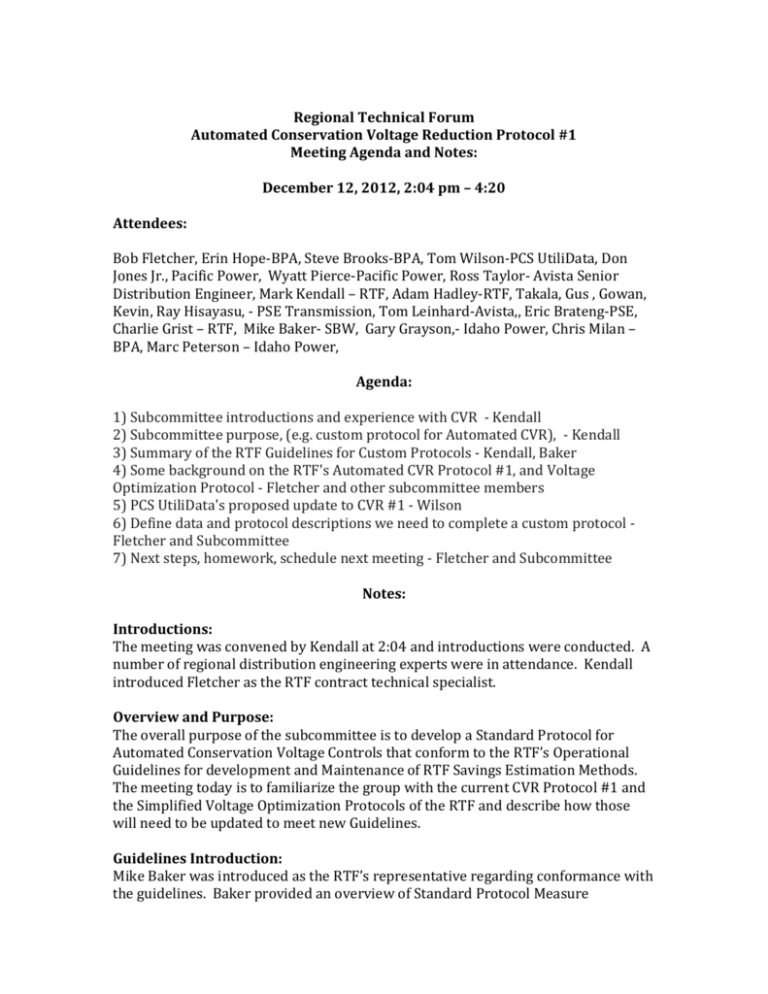
Regional Technical Forum Automated Conservation Voltage Reduction Protocol #1 Meeting Agenda and Notes: December 12, 2012, 2:04 pm – 4:20 Attendees: Bob Fletcher, Erin Hope-BPA, Steve Brooks-BPA, Tom Wilson-PCS UtiliData, Don Jones Jr., Pacific Power, Wyatt Pierce-Pacific Power, Ross Taylor- Avista Senior Distribution Engineer, Mark Kendall – RTF, Adam Hadley-RTF, Takala, Gus , Gowan, Kevin, Ray Hisayasu, - PSE Transmission, Tom Leinhard-Avista,, Eric Brateng-PSE, Charlie Grist – RTF, Mike Baker- SBW, Gary Grayson,- Idaho Power, Chris Milan – BPA, Marc Peterson – Idaho Power, Agenda: 1) Subcommittee introductions and experience with CVR - Kendall 2) Subcommittee purpose, (e.g. custom protocol for Automated CVR), - Kendall 3) Summary of the RTF Guidelines for Custom Protocols - Kendall, Baker 4) Some background on the RTF's Automated CVR Protocol #1, and Voltage Optimization Protocol - Fletcher and other subcommittee members 5) PCS UtiliData's proposed update to CVR #1 - Wilson 6) Define data and protocol descriptions we need to complete a custom protocol Fletcher and Subcommittee 7) Next steps, homework, schedule next meeting - Fletcher and Subcommittee Notes: Introductions: The meeting was convened by Kendall at 2:04 and introductions were conducted. A number of regional distribution engineering experts were in attendance. Kendall introduced Fletcher as the RTF contract technical specialist. Overview and Purpose: The overall purpose of the subcommittee is to develop a Standard Protocol for Automated Conservation Voltage Controls that conform to the RTF’s Operational Guidelines for development and Maintenance of RTF Savings Estimation Methods. The meeting today is to familiarize the group with the current CVR Protocol #1 and the Simplified Voltage Optimization Protocols of the RTF and describe how those will need to be updated to meet new Guidelines. Guidelines Introduction: Mike Baker was introduced as the RTF’s representative regarding conformance with the guidelines. Baker provided an overview of Standard Protocol Measure requirements. Mike defined a standard protocol, defined why the CVR technology did not fit the RTF custom protocol guidelines and proceeded to identify what is needed for the RTF to approve a standard protocol. Baker identified the data standards, the pre and post measurement required to provisionally prove the protocol is accurate on a sample of projects, the measure and procedure specification standard, the energy estimation methods (statistical, engineering….), the baseline definition and defining it, the efficient case definition and verification requirements, and all the documentation required of the practitioner and for the protocol itself. See the Guidelines for Development and Maintenance of RTF Savings Estimation Methods at the RTF web site for detail. A very high level summary was presented in a PowerPoint presentation. CVR Protocol #1 and Optimized Voltage Control History and Characteristics: Fletcher prepared and presented two power point slide shows (posted on the Subcommittee Web Page): Simplified VO Protocol 2010 Discussion (slides 1-15) CVR No.1 Protocol 2004 Discussion (slides 1-6) Other documents were provided to the group with the meeting announcement for their review and reference: Voltage Optimization Protocol 2010 Automated CVR Protocol 2004 Automated CVR Performance Estimation Methods 2004 Guidelines for RTF Savings Estimation Methods Guidelines for MV Federal Projects IPMVP Guidelines 2002 Discussion included many technical aspects of dealing with various elements of distribution feeders. For example, the protocol is lacking instruction on how to select and document the site for measurement of line voltage (substation, end of line, average…) when there are line drop compensators, power factor correction or other switching on distribution lines being treated with CVR. The protocol needs to address those issues. The following questions were raised during the discussion that address what is needed for the protocol to be well understood, savings estimation reliable and transparent and methodology clear enough to be assured of replicability. The automated CVR protocol questions, and issues that need to be addressed to meet the guidelines criteria include: 1. Does the CVR Protocol No 1 meet minimum RTF guidelines for Custom SiteSpecific savings estimate and cost-effectiveness calculation methodology? 2. Is the CVR Protocol No 1 applicable to a wide variety of distribution systems configurations and operation practices (residential feeders, commercial, industrial, mixed feeders, inside industrial facilities)? 3. Does the CVR Protocol No 1 adequately ensure comprehensive distribution system cost-effective efficiency? This was raised as not being the point of the protocol by some others. 4. Does the CVR Protocol No 1 adequately ensure that distribution system safety and facility standards are meet? The protocol must operate within the safety requirements and constraints of the utility. 5. What changes are necessary to simplify the automated CVR protocol requirements and calculation methods? 6. Verification of statistical methods to adequately evaluate savings 7. Simplified statistical measure savings calculation methods clearly apply to the field data collected 8. Distribution load flow analysis requirements 9. Facility data requirements of lines, equipment, and loads 10. Characteristic load models (ZIP) requirements 11. Historical load data and temperature data requirements 12. Distribution system efficiency impacts 13. Location and number of voltage EOL measurements need to be specifically defined. 14. Location and number of temperature sensors 15. Voltage measurement locations (e.g., Veol, Vsub, Vreg, Vcap) defined in the protocol 16. System average voltage or end-of-line average voltage measurement locations or averaging method from data collected 17. System performance requirements (i.e., Vmax, Vmin PFmin, VDsec-max, Vsource-max, VDpri-max, Control Bandwidth) 18. Does the standard protocol apply to wide variety of automated CVR volt/var systems and vendors equipment? Proposed Protocol Reviewed: Tom Wilson of PCS UtiliData reviewed the draft protocol text itself, by category. He discussed the sections that addressed: the purpose of the protocol (scope), sunset criteria for the protocol, definition of key terms, eligible project definitions, required practitioner knowledge, data collection requirements, post period re-verification triggers, baseline performance, method description, the model and savings estimation method, the control groups required, relationship to other RTF or other protocols, and the recommended methods and/or tools for conducting the verification and calculation. He provided a draft protocol in the current RTF format which is posted at the RTF subcommittee web page. Discussion raised the following questions regarding the proposed protocol language. The best practice for the protocol is not clearly described and it appears that the protocol itself may be the best practice, The data collection description does not specifically describe how one chooses the "other" months for the data collection period, The calculator algorythms are not specifically described and the calculator transparency is not described, The skills required of the practitioner do not appear to be "widely represented" in the region as indicated for a Standard Protocol, Use and incorporation of time series data in the algorythms and calculator are not clearly enough described that we can assure that practitioners will yield the same result subsequent times or across practitioners. Written comments from Subcommittee (PacifiCorp): Section 1, Purpose, should include a brief scope definition that differentiates the applicability of the protocol to utilities that (a) already have automated CVR systems in place and seek more accurate M&V, (b) utilities that are evaluating the potential cost effectiveness of an automated CVR system but have not yet implemented one. This section could point the reader to appropriate resources for estimating the savings that would cost justify the implementation of an automated CVR system (I.e. those in category (b), who cannot use this protocol to justify a future installation of an automated CVR system). Section 3, Definition of Terms, provides a somewhat misleading definition of CVR. The most general purpose of CVR is to use less energy in aggregate, recognizing that some utilization devices (LCD and plasma televisions, for instance) use more energy at a lower voltage. A more accurate description might be: Conservation Voltage Regulation/Reduction (CVR): CVR is the operating practice of controlling distribution feeder voltage with the goal of using less total electrical energy and reducing electrical demand. This is accomplished by providing a utilization voltage near the low end of the acceptable range and/or rated voltage, where many utilization devices operate at their peak efficiency. Section 3, Definition of Terms, further propagates existing confusion over the difference between CVR and VO factors. The RTF has previously made the distinction (see May 4, 2010 RTF Meeting) that VO factors apply to end-use utilization, while CVR factors include both the end-use and distribution system savings. This section explicitly references the utilization device’s efficiency curve, which should apply to a VO factor, not a CVR factor. If the protocol is to use the term “CVR factor,” then it should explain why “VO factor” is not the more appropriate and consistent term. Section 3, Definition of Terms, does not define the terms “heating regime hours” and “cooling regime hours,” which are used in Section 7. Section 4, Eligible Projects, appears to describe a fully implemented pilot project. If the protocol is not intended for pilot projects, this would be a good location to mention refinements in calculations that improve upon the M&V methods and assumptions used prior to 2011. That is to say, a utility with a system that fits this definition must have been using some other method to calculate savings until now, and that method is evidently not as accurate as the method described in the protocol. Section 5, Required Knowledge, describes an extremely specialized individual. In fact, given the ongoing research into the physics of CVR by institutions such as EPRI, NEETRAC, PNNL, and others, probably no person could legitimately claim to have “full understanding” of the first bullet. The remainder of the bullets appear to lean heavily on the characteristics of the submitter, and would not describe a party who is reading the protocol for guidance. A more reasonable description of attributes might be: Knowledge and Skills of Practitioner The practitioner who has lead responsibility for applying this protocol to an automated CVR system should have appropriate knowledge of the following: The application of CVR to distribution systems and the underlying physics of relationships between operating voltage levels and energy consumption The use of engineering time series analysis The use of Robust Statistical procedures used to analyze non-Gaussian data Distribution feeder and substation operations This protocol, and specifically its requirements and procedures The practitioner must also be able to successfully: Operate an appropriate time series load flow application, such as Gridlab-D, OpenDSS, or MatLab Inspect and interpret raw feeder energy and voltage data Section 6.b, Metering and Data, should include a requirement to record the number of operations on the regulating device(s), for the purpose of identifying any increase in equipment maintenance costs or reduction in equipment life. Section 9.b, Program Savings, is missing a line break in the third bullet, between GWh and CVRf. Section 9.c, CVRf Estimation, appears to describe a method which yields a value with kWh/volt units, which does not match the Definition of Terms in Section 3. The 24hour sum of the difference between the integrated demand profiles should be divided by an energy value (such as the total inactive temperature-corrected energy) to get a unitless “energy” value. The mean difference in end of circuit voltages should be divided by a voltage value (such as the mean inactive end of circuit voltage) to produce a unitless “voltage” value. Then the two unitless values could be divided to produce the CVR factor that is described in the Definition of Terms. Section 10, Model, states that energy usage has been compensated by temperature. The surrounding discussion (Sections 4 and 6) suggests the compensation accounts for hourly temperature values. It should be observed that the circuit load on a cold day can be substantially less than the circuit load on the third or fourth cold day in a row, even if the temperature is the same each day. If this is accounted for in the model, it should be stated here. If it is not accounted for in the model, it should be listed as one of the additional factors that will improve accuracy. Next Steps and Schedule: A couple members of the group want to bring Kevin Schneider of PNNL into the discussion. He is knowledgable, has applies CVR and conducted evaluations and protocol analysis. One person brought up that other manufacturers such as GE, Siemens, Beckwith Electric, ABB or others should be involved. The next steps include: 1. Develop four separate protocols for subcommittee review: a. Update Automated CVR Protocol #1 for feeders with existing conditions b. Automated CVR for feeders that are optimized to IEEE standards c. Optimized feeders (reconductoring, capacitance, voltage drop compensation, phase balancing…) d. Update the Voltage Optimization Protocol 2. RTF staff posting the presentation(s) and discussion. On a Subcommittee web page. 3. UtiliData and Fletcher identify some responses to the questions raised and relate them specifically to the pertinent sections of the draft protocol. 4. Have protocol language editing Subcommittee meeting for each protocol. 5. Develop calculator specifications and calculator for testing on the 31 NEEA feeder data. (RTF to collect from RW Beck).
